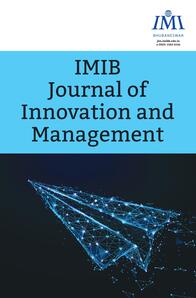
1 Department of Commerce, University School of Business, Chandigarh University, Mohali, Punjab, India
2 Department of Commerce, Mahatama Gandhi Kashi Vidyapith, Varanasi, Uttar Pradesh, India
Creative Commons Non Commercial CC BY-NC: This article is distributed under the terms of the Creative Commons Attribution-NonCommercial 4.0 License (http://www.creativecommons.org/licenses/by-nc/4.0/) which permits non-Commercial use, reproduction and distribution of the work without further permission provided the original work is attributed.
Companies now have been more aware of the increasing necessity of integrating environmental and human resources management practices. Green human resource management (GHRM) uses human resource management (HRM) strategies to foster sustainable resource usage in corporate organisations and advances the issues of environmental sustainability through disruptive technologies. To foster the implementation of GHRM uniformly throughout industries across the world could only reflect the marginal impact on environmental sustainability. The purpose of the research article is to identify whether the adoption of GHRM in the organisation brought behavioural change among employees towards organisational commitment that could lead environmental sustainability. The study is conducted amongst different public and private sector banks in the Varanasi district of Uttar Pradesh, India, through primary data collection of 330 respondents. For analysing the adoptability of green behaviour amongst employees in the organisation, we have adopted structural equation modelling to examine the employee’s commitment. The test result of the above tool of studying the four different latent variables leads us to conclude that path analysis and load factor exhibited stronger relationship through post-moderating effect, that is, latent variables lead towards green commitment. This leads us to conclude that organisations are trying to get environmental sustainability through GHRM practices, which in turn gives them a status of an environmentally sensitive organisation as well as some edge in this competitive environment. As a policy government is also expecting from organisations to develop themselves as environmentally sensitive by providing impetus of employee’s commitment.
GHRM, disruptive technology, environmental sustainability, human resource management, PLS-SEM
Blok, V., Wesselink, R., Studynka, O., & Kemp, R. (2015). Encouraging sustainability in the workplace: A survey on the pro-environmental behaviour of university employees. Journal of Cleaner Production, 106, 55–67. https://doi.org/10.1016/j.jclepro.2014.07.063
Cohen, E., Taylor, S., & Muller-Camen, M. (2012). HRM’s role in corporate social and environmental sustainability [Research report]. Society of Human Resources Management. https://www.shrm.org/hr-today/trends-and-forecasting/special-reports-and-expert-views/Documents/Corporate-Social-Environmental-Sustainability.pdf
Daily, B. F., & Huang, S. (2001). Achieving sustainability through attention to human resource factors in environmental management. International Journal of Operations and Production Management, 21(12), 1539–1552. https://doi.org/10.1108/01443570110410892
García-Machado, J. J., & Martínez-Ávila, M. (2019). Environmental performance and green culture: The mediating effect of green innovation—An Application to the Automotive Industry. Sustainability, 11(18), 4874. https://doi.org/10.3390/su11184874
Kim, A., Kim, Y., Han, K., Jackson, S. E., & Ployhart, R. E. (2017). Multilevel influences on voluntary workplace green behavior: Individual differences, leader behavior, and coworker advocacy. Journal of Management [Advance online publication], 43(5), 1335–1358. https://doi.org/10.1177/0149206314547386
Lülfs, R., & Hahn, R. (2013). Corporate greening beyond formal programs, initiatives, and systems: A conceptual model for voluntary pro-environmental behavior of employees. European Management Review, 10(2), 83–98. https://doi.org/10.1111/emre.12008
Mandip, G. (2015). December the journal of Nepalese business studies. Green HRM—People management commitment to environmental sustainability. Research Journal of Recent Sciences, 9, 244–252.
Mehta, K., Chugan, P. K., Pawan Kumar, & Green, H. R. M. (June 2015). Pursuit of environmentally sustainable business. Universal Journal of Industrial and Business Management, 3(3), 74–81.
Mukherjee, S., Bhattacharjee, S., Paul, N., & Banerjee, U. (2020). Assessing green human resource management practices in higher educational institute. Test Engineering and Management, 82. https://papers.ssrn.com/sol3/papers.cfm?abstract_id=3546928
Norton, T. A., Parker, S. L., Zacher, H., & Ashkanasy, N. M. (2015). Employee green behavior: A theoretical framework, multilevel review, and future research agenda. Organization and Environment, 28(1), 103–125. https://doi.org/10.1177/1086026615575773
Renwick, D. W. S., Redman, T., & Maguire, S. (2013). Green HRM: A review and research agenda. International Journal of Management Reviews, 15(1), 1–14. https://doi.org/10.1111/j.1468-2370.2011.00328.x
Robertson, J. L., & Barling, J. (2013). Greening organizations through leaders’ influence on employees’ pro-environmental behaviors. Journal of Organizational Behavior, 34(2), 176–194. https://doi.org/10.1002/job.1820
Robinson, F. (2008). Going green: What does it really mean? http://ezinearticles.com/?Going-green!-What-does-it-really-mean?&kd=2267926
Vicente-Molina, M. A., Fernández-Sáinz, A., & Izagirre-Olaizola, J. (2013). Environmental knowledge and other variables affecting pro-environmental behaviour: Comparison of university students from emerging and advanced countries. Journal of Cleaner Production, 61, 130–138. https://doi.org/10.1016/j.jclepro.2013.05.015
WCED. (1987). Our common future. Oxford University Press.
Zibarras, L. D., & Coan, P. (2015). HRM practices used to promote pro-environmental behavior: A UK survey. International Journal of Human Resource Management, 26(16), 2121–2142. https://doi.org/10.1080/09585192.2014.972429
Zsóka, Á., Szerényi, Z. M., Széchy, A., & Kocsis, T. (2013). Greening due to environmental education? Environmental knowledge, attitudes, consumer behavior and everyday pro-environmental activities of Hungarian high school and university students. Journal of Cleaner Production, 48, 126–138. https://doi.org/10.1016/j.jclepro.2012.11.030
Zubair, S. S., & Khan, M. (2019). Sustainable development: The role of green HRM. International Journal of Research in Human Resource Management, 1(2), 1–6.